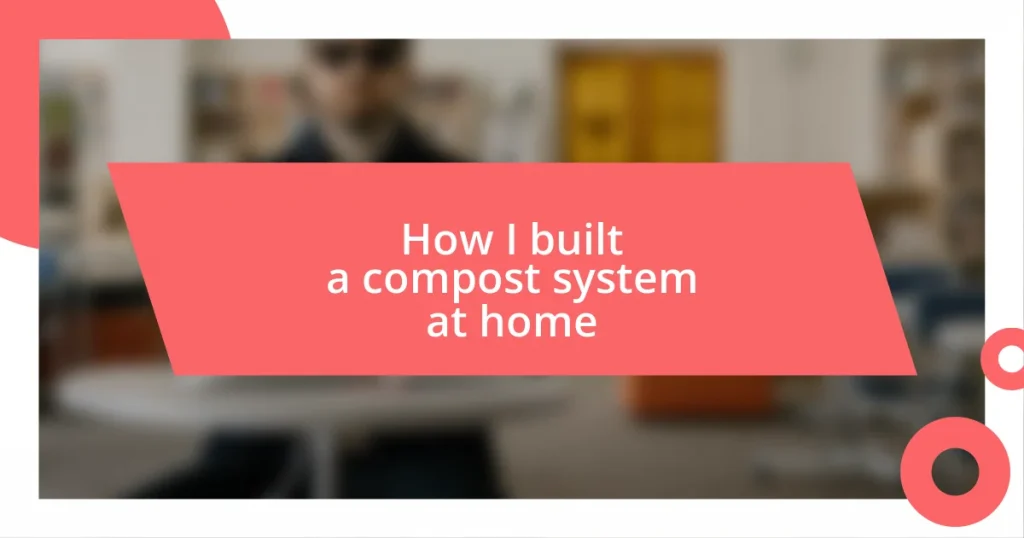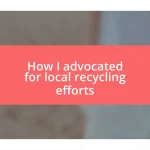Key takeaways:
- Composting involves balancing “greens” (food scraps) and “browns” (dried leaves) to create nutrient-rich soil, aided by microorganisms.
- Choosing the right compost bin is crucial for motivation; consider factors like size, aeration, accessibility, and aesthetics.
- Regular maintenance, including turning the compost and monitoring moisture levels, is essential for a successful composting process.
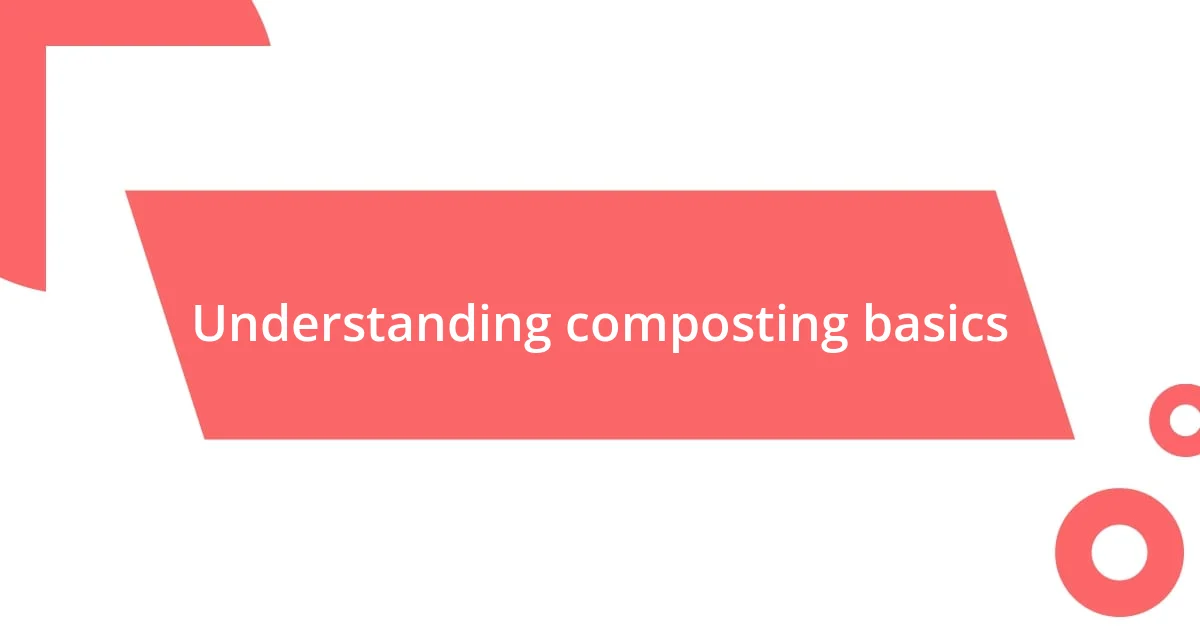
Understanding composting basics
Composting is a fascinating process that transforms organic waste into nutrient-rich soil. When I first heard about it, I was skeptical. How could old vegetable scraps and yard waste become something so valuable? But as I dove deeper into composting, I realized it’s all about the right balance of materials – a mix of “greens” (like food scraps) and “browns” (like dried leaves) is crucial.
One of the most surprising aspects of composting for me was the science behind it. It’s not just tossing waste in a pile and hoping for the best! Microorganisms, like bacteria and fungi, play a star role in breaking down these materials. I remember the first time I opened my compost bin to discover the rich, dark soil inside. It felt like uncovering hidden treasure.
A common misconception is that composting is complicated, but it doesn’t have to be. Honestly, I started with a simple container and learned as I went along. Do you ever feel overwhelmed by the idea of starting something new? I did too, but once I understood the basics, it became an enjoyable part of my routine. With just a little patience and attention, anyone can create a thriving compost system at home.
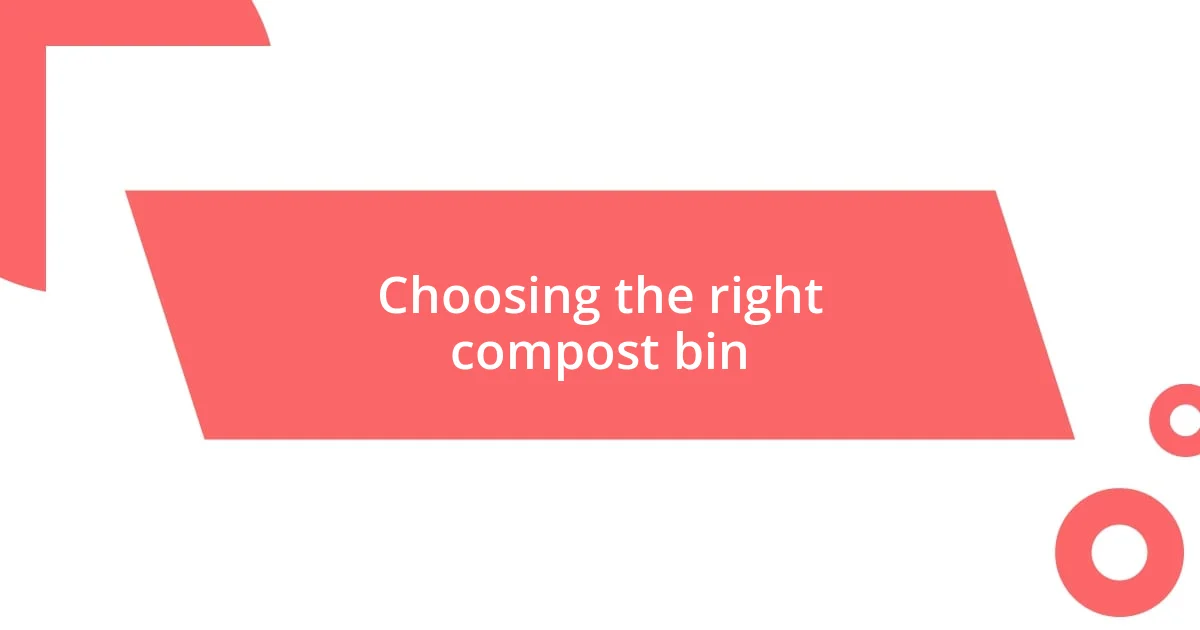
Choosing the right compost bin
When I was choosing my compost bin, I quickly realized that the right design could make or break my composting experience. I tried several types before I settled on a tumbler, which I found incredibly user-friendly. Finding a bin that fits your space and needs is essential—it’s not just about convenience; it’s about motivation. If you enjoy the process, you’re more likely to commit to it!
Here are some key factors to consider when selecting a compost bin:
- Size: Think about how much waste your household generates. A larger bin may be necessary for bigger families.
- Material: Plastic, wood, or metal? Each has its pros and cons regarding durability and insulation.
- Aeration: A bin that allows for airflow will speed up decomposition—ventilation is key!
- Accessibility: Make sure you can easily add waste and retrieve your compost. If it’s too much work, you might lose interest.
- Cost: Set a budget. You can build a bin yourself, or invest in a high-quality one.
- Aesthetics: Consider how it fits into your outdoor space—don’t be afraid to choose a design that pleases your eye.
I remember standing in my yard, overwhelmed by the options. Each one seemed to promise a different composting adventure. But, after a bit of trial and error, I found the perfect fit that encouraged me to keep going. The joy of nurturing my compost is now one of my favorite pastimes!
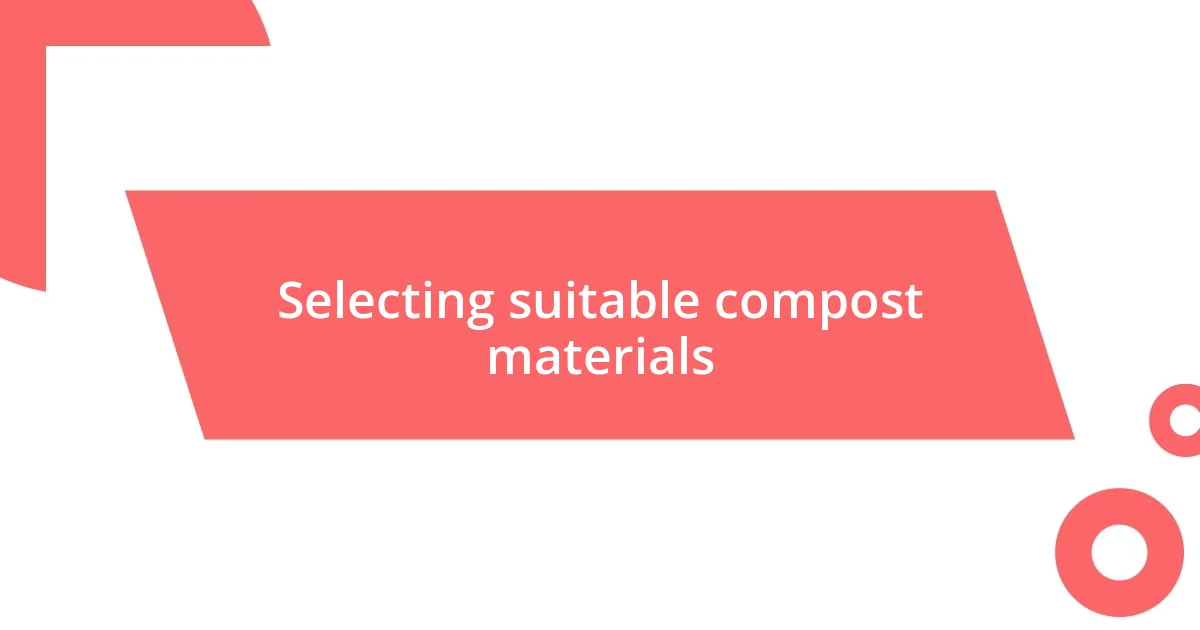
Selecting suitable compost materials
Selecting suitable compost materials is a crucial step in the composting process. I found my best results came from simply observing what I had on hand. Balancing “greens”—such as fruit and vegetable scraps—with “browns,” like dried leaves or cardboard, transformed my compost into nutrient-rich soil. It took some experimenting for me to realize the importance of this balance. If you ever wonder why your compost isn’t breaking down efficiently, it could be that you’re missing this very mix!
In my experience, I’ve learned to be cautious about what I throw into the compost pile. Some materials may seem harmless but can actually hinder the composting process. For example, citrus peels can create an acidic environment that may discourage certain microorganisms. I recall when I added too much of a single material, and my compost became a smelly mess. The lesson I learned? Variety really does matter!
To make things easier, I came up with a simple chart to help me select compost materials. It keeps me organized and ensures I’m adding the right mix.
| Greens | Browns |
|---|---|
| Fruit scraps | Dried leaves |
| Vegetable scraps | Shredded newspaper |
| Coffee grounds | Cardboard |
Having this visual aid has made my composting journey much more enjoyable and efficient. I recommend creating one for yourself; it really helps in making more informed choices about what goes into your compost pile. Do you have a favorite compost material? I’d love to know!
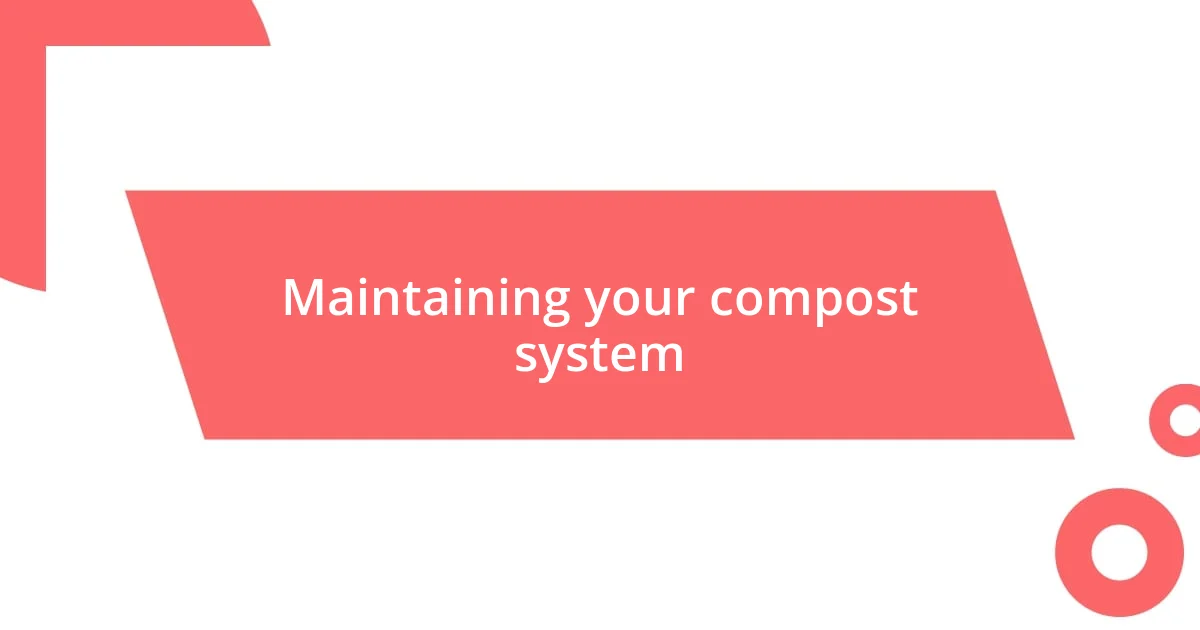
Maintaining your compost system
Maintaining your compost system is essential for creating rich, nutritious soil. I’ve found that regularly turning the compost not only aerates the pile but speeds up the decomposition process. At first, I would forget to do this, and my compost would clump together, making it more challenging to break down. Now, I enjoy the ritual—taking a few minutes to mix things up really feels rewarding.
Another important aspect is monitoring moisture levels. Too dry, and your compost will stall; too wet, and it could start to smell. I remember one time when I neglected to check the moisture, and my compost turned into a sour, mushy mess. It was a wake-up call! Since then, I always keep a spray bottle handy. A light mist on those hot days can rejuvenate the pile and keep the microbes thriving.
Finally, don’t forget to troubleshoot! If something seems off, it’s always worth taking a closer look. Is the compost too hot or too cold? What materials are breaking down well, and what are not? I’ve learned to keep a journal of my observations. Reflecting on my successes and challenges helps me improve continuously and keeps me engaged. Have you kept track of your own composting journey? It can make a significant difference!
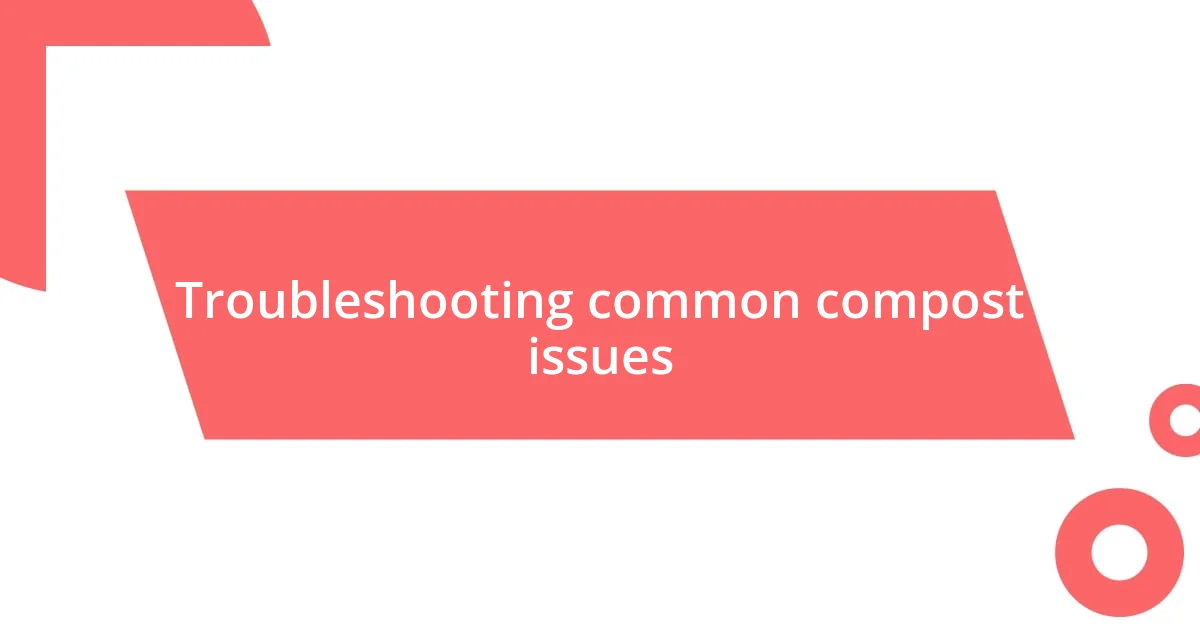
Troubleshooting common compost issues
When I first started composting, I was shocked at how often things didn’t go as planned. One common issue I faced was a pile that just wouldn’t heat up. After digging deeper, I realized my mix was off—too many browns and not enough greens. It’s funny how something as simple as an imbalance can throw everything off! Have you ever dealt with a cold compost? Adding a bit more kitchen scraps did the trick for me, and watching the temperature rise felt like a mini victory.
Then there was the time my compost emitted a foul odor. It was quite overwhelming, and honestly, a bit embarrassing. After some research and a little reflection, I discovered it was likely due to over-watering and a lack of aeration. I took action by turning the pile more frequently and ensuring adequate drainage. The smell diminished, and it reinforced the importance of paying attention to environmental factors. Have you had a stinky compost experience? I bet you learned something valuable, too!
Lastly, I often found pieces of my compost still intact even after weeks. This was a puzzling moment for me; I thought everything would break down faster. I learned that larger items take longer to decompose, so now, I make a habit of chopping up materials into smaller pieces. I’ve noticed a major difference since then! It’s almost therapeutic to watch everything transform into rich soil. What about you? Have you changed your approach based on what you’ve observed in your composting journey? Each little tweak makes a difference!
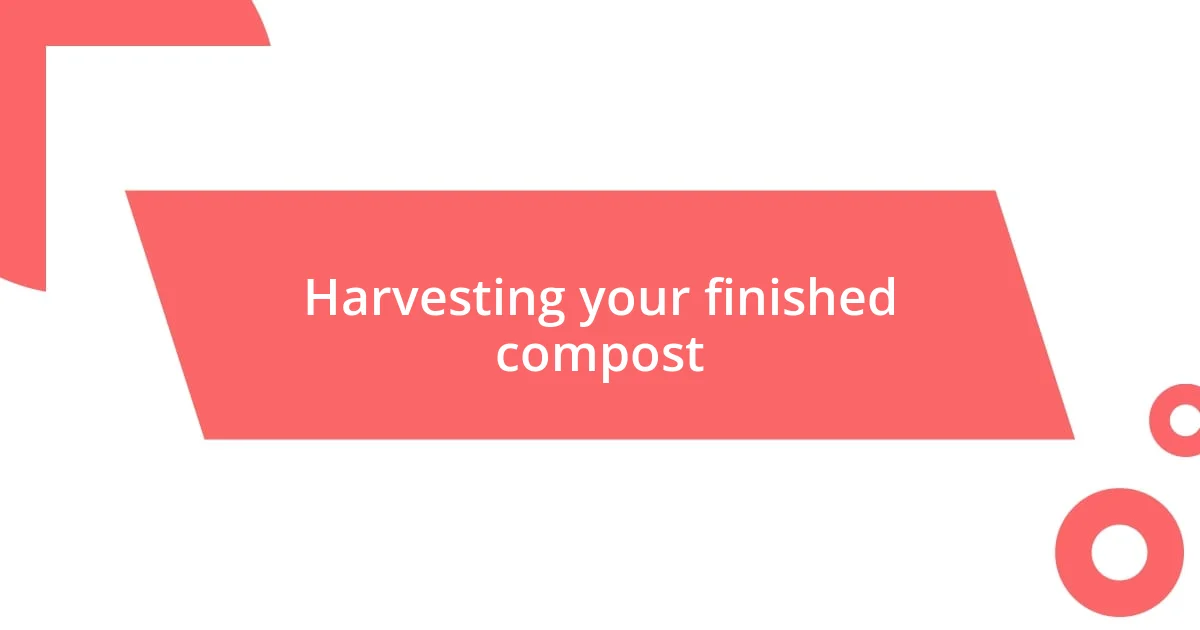
Harvesting your finished compost
Harvesting finished compost is genuinely one of the most satisfying moments in the composting process. When the compost is dark, crumbly, and has that earthy smell, you know it’s ready to be used. I remember the first time I scooped it up—seeing all the vibrant life it had transformed into felt like discovering buried treasure in my backyard.
As I prepared to harvest, I realized that it’s not just about collection; it’s also about ensuring the compost is on the finer side. I often run my hands through it to break up any larger chunks. This step is crucial if you want a uniform texture for your garden. Honestly, it’s a bit messy, but that’s part of the joy, right? The occasional dirt under my nails reminds me that I’m getting my hands dirty for a good cause.
I often think about the cycle of life that’s happening right before my eyes. After harvesting, I take a moment to reflect on the kitchen scraps and yard waste that once seemed useless. It makes me wonder—what other things in our lives could be transformed with a little patience and care? Just like I did with those scraps, sometimes our challenges can turn into something beautiful if we nurture them. It’s a powerful reminder not to overlook the potential around us.
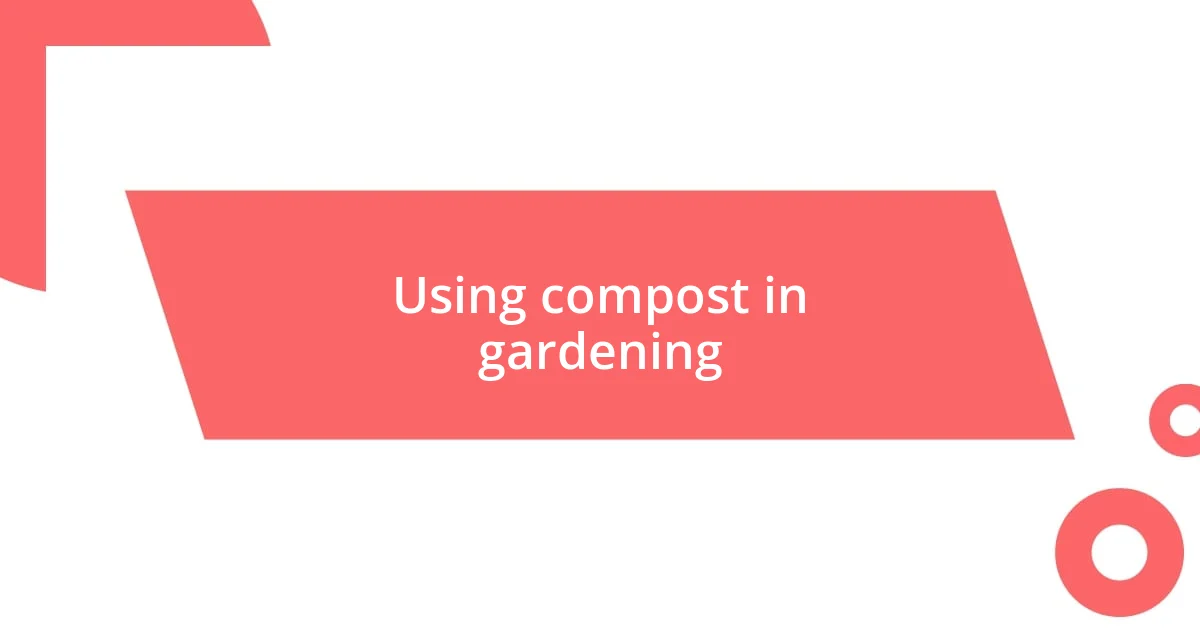
Using compost in gardening
Using compost in gardening transforms not only your soil but also your connection to the natural cycle of growth. When I first introduced compost into my garden, the changes astounded me. I vividly recall planting tomatoes in soil enriched with my homemade compost; the plants didn’t just thrive, they exploded with life! Have you felt that rush of excitement when your garden flourishes due to your efforts? It’s such a rewarding experience.
As I worked with compost over time, I learned that it’s a powerful way to improve soil structure and nutrient content. The beauty of compost is that it promotes a rich, dark soil teeming with beneficial microbes that support plant health. I often sprinkle compost around my perennials and vegetables like a secret ingredient, and the difference in growth and yield is substantial. Don’t you think it’s incredible how a simple mix of organic waste can create such lush results?
One of my favorite gardening routines now includes using compost as a top dressing. Just the other day, I spread a layer around my flowering plants, and I couldn’t help but smile at how much they seemed to appreciate it. Watching them perk up and show new growth made me feel like I was part of something bigger. It makes me wonder—what other unexpected joys could our gardening choices unlock? Gardening with compost feels like a beautiful conversation between nature and myself, one that I cherish deeply.










